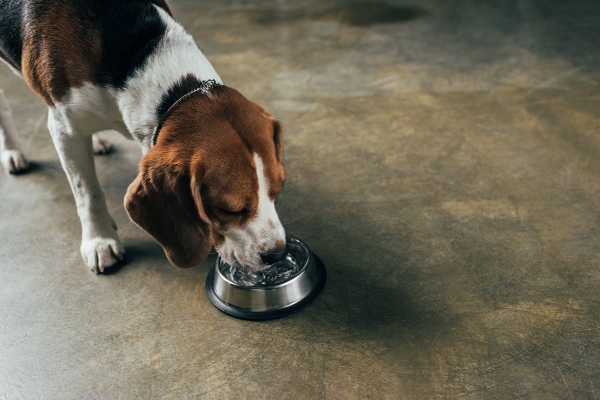Diabetic ketoacidosis in dogs (i.e. DKA in dogs) is a potentially life-threatening complication of diabetes mellitus. To help dog parents recognize and understand DKA, integrative veterinarian Dr. Julie Buzby explains the causes, symptoms, diagnosis, and treatment of diabetic ketoacidosis in dogs.

As I arrived at work one Monday morning, I received an email from our local veterinary emergency hospital. They alerted me that one of my longtime patients, a sweet older Beagle name Bea, had been hospitalized over the weekend for diabetic ketoacidosis (DKA).
I was concerned. Although roughly 70% of dogs survive this diagnosis, I worried Bea might fall into that other 30%. Let’s talk about why I was so worried about DKA in dogs.
What is diabetic ketoacidosis in dogs?
Diabetic ketoacidosis (DKA) in dogs is a serious and life-threatening complication of uncontrolled diabetes mellitus. In some cases, the affected dog had previously been diagnosed with diabetes. So the DKA diagnosis is upsetting but not as shocking to the dog’s family.
However, in many cases, the vet makes the diagnosis of DKA at the same time as the diagnosis of diabetes mellitus. For these dog parents, a diabetic ketoacidosis diagnosis is a double whammy. They find out their dog is sick with DKA, a major, life-threatening illness. And at the same time, they also learn that their canine companion has a chronic medical condition, diabetes mellitus.
We’ll get into more details about diabetic ketoacidosis soon. But first, it will be helpful to know the basics of diabetes mellitus in dogs (i.e. “sugar diabetes”—not to be confused with diabetes insipidus in dogs or “water diabetes”).
Diabetes mellitus in dogs
In normal, healthy dogs, the pancreas secretes the hormone insulin. Insulin acts like a key to unlock the door for glucose (i.e. sugar) to enter cells. Just like people, dogs use the simple sugar glucose as the main energy source within their cells.
In diabetic patients, one of two things can happen. Sometimes the pancreas isn’t making insulin. Other times, the cells don’t respond to the insulin the pancreas is making. Either way, the end result is that the cells are starving for energy, and there is a massive buildup of glucose circulating uselessly in the bloodstream.
If this situation persists for long enough, the body turns to breaking down fat stores for energy. This provides an adequate short-term solution to the energy crisis. And it allows red blood cells and brain cells to continue to function.
But, if the cells remain unable to use glucose and continue to have to rely on fat for energy, a byproduct of fat breakdown, ketones, can build up in the bloodstream. Glucose and ketones act differently in the body, so ketone build up can be problematic.

Ketones
Ketones, also known as ketone bodies, don’t normally cause any harm in small amounts or for short periods of time. They are a normal product of breaking down fat in the body.
However, in dogs with uncontrolled diabetes, ketones keep building up. Ultimately, they accumulate in larger amounts than the body can handle. High ketone levels in the blood can lead to dangerous acid-based problems and shifts in vital electrolyte levels. Plus, they worsen dehydration and cause nausea and vomiting.
Diabetes + ketones = diabetic ketoacidosis
The build-up of ketones in the blood is known as ketosis. Since ketone bodies are acids, one of the most dangerous things about ketosis is that it goes hand in hand with acidosis (i.e. blood that is too acidic). When you add those two problems together, you get “ketoacidosis” which is the “KA” in DKA.
Dogs, and really all mammals, have many fail-safe mechanisms to help keep their blood at a very specific pH. The normal pH of a dog’s blood should generally be between 7.35 and 7.45.
If the blood pH falls even a tiny bit outside of this normal range—becoming either too basic or too acidic—havoc ensues. Many vital cellular processes don’t work correctly outside of the normal pH range. And as a secondary effect of canine ketoacidosis, a dog may develop dangerous electrolyte abnormalities, including changes in potassium and phosphorus.
All of these potentially life-threatening complications need to be addressed as soon as possible. But why does DKA in dogs occur?
What causes diabetic ketoacidosis in dogs?
Diabetic ketoacidosis is usually caused by a “stressor” that adds to the dog’s preexisting diabetes (whether or not it’s been diagnosed yet).
We are all familiar with the idiom “the straw that broke the camel’s back.” And when it comes to DKA, there is almost always a “straw” that sends a dog from a state of uncontrolled diabetes into full-blown diabetic ketoacidosis. Since the dog’s body is already dealing with the heavy burden of diabetes, adding another ailment can push things over the edge.
The three most common concurrent illnesses are urinary tract infections, pancreatitis, and Cushing’s disease.
Diabetic ketoacidosis and urinary tract infections in dogs
Diabetic dogs are predisposed to urinary tract infections (UTI in dogs). A lack of insulin (or lack of response to insulin) causes diabetic dogs to have large amounts of glucose circulating freely in their bloodstream. This glucose spills into the urine, where it becomes a perfect food source for bacteria.
It is no wonder then that roughly one in five dogs with diabetic ketoacidosis will also have a UTI. Even an uncomplicated UTI can cause enough physiologic stress to push a diabetic dog into ketoacidosis. Thankfully though, vets can easily treat most UTIs with antibiotics.
Diabetic ketoacidosis and pancreatitis in dogs
Pancreatitis in dogs is inflammation of the pancreas—the organ that sits tucked between the liver and gallbladder. Normally, the pancreas is responsible for making important hormones like insulin. And it also secretes enzymes that help digest food in the intestinal tract.
For reasons that aren’t always understood, the pancreas can become inflamed. And then it will release those digestive enzymes more haphazardly into the surrounding tissues instead of directly into the small intestines. As you can imagine, the tissues in the area don’t take too kindly to their digestive enzyme bath. The result is significant inflammation, abdominal pain, decreased appetite, nausea, and vomiting.
In addition to contributing to DKA, pancreatitis can make treating diabetic ketoacidosis more challenging. The inflammation from the pancreas makes blood glucose more difficult to control. Feeling crummy from pancreatitis can lengthen the time it takes to start eating again and regulate blood sugar.

Although there is no magical cure for pancreatitis, new medications such as Panoquell can help alleviate some of the symptoms. Pancreatitis treatment primarily involves supportive care. Dogs may benefit from anti-nausea medications like Cerenia for dogs. And the vet may feed a dog with pancreatitis a low-fat diet.
Diabetic ketoacidosis and Cushing’s disease in dogs
Cushing’s disease in dogs, also known as hyperadrenocorticism, is caused by the increased production of cortisol (i.e. stress hormones) from the adrenal glands.
Cushing’s doesn’t generally make dogs feel sick. Instead, it causes signs like increased thirst and urination, an increased appetite, panting, thinning fur, and a pot-bellied dog appearance. Some of these signs overlap with symptoms of diabetes, so be sure to watch for patterns in your dog’s behavior and health.
Because dogs with Cushing’s disease produce extra stress hormones, they can develop insulin resistance (i.e. poor response to insulin) and make diabetes more challenging to control. So, if your veterinarian suspects that your dog has Cushing’s, he or she will probably recommend additional blood tests to confirm or rule out this diagnosis.
However, if a dog is hospitalized for DKA, then it is a good plan to wait a few weeks to test for Cushing’s. This is because the stress related to a dog’s DKA and time in the hospital can raise cortisol levels, making the test results hard to interpret.
Once your dog has recovered from DKA, diagnosing and treating Cushing’s disease can help maintain good diabetic control long-term.
Other conditions that can contribute to DKA in dogs
These three conditions—UTIs, pancreatitis, and Cushing’s disease—are the most common triggers for canine ketoacidosis. But keep in mind that almost any significant stress or illness could predispose a diabetic dog to developing diabetic ketoacidosis. For example, other illnesses that have been implicated include kidney infections (i.e. pyelonephritis in dogs), heart disease in dogs, liver or gallbladder infections, and cancer.
What are the symptoms of diabetic ketoacidosis in dogs?
Many of the signs of DKA on this list will overlap with the signs of diabetes mellitus. This makes sense since all dogs with DKA start out as diabetic. And then stressor or concurrent disease process pushes them into a state of diabetic ketoacidosis.
However, when compared to dogs who “just” have diabetes, the majority of dogs diagnosed with DKA are quite sick. And most demonstrate many more signs of severe illness.
Signs of diabetic ketoacidosis include any combination of the following:
- Increased urination—the kidneys have to work extra hard to filter excess sugar in the blood, leading to increased urine output.
- Increased thirst in dogs—what goes out must come in; dogs in DKA have to drink a lot more water to make up for the loss through urine.
- Weight loss—because the dog can’t properly metabolize glucose, the body breaks down fats and proteins for cellular energy.
- Muscle wasting—altered energy metabolism deprives muscle cells of energy, so muscles can start to deteriorate.
- Decreased appetite—the electrolyte imbalances and acid base problems caused by DKA can make dogs feel bad and not want to eat.
- Nausea—similarly, the blood chemistry disturbances in DKA can cause nausea.
- Vomiting—nausea can become severe enough that dogs with DKA may vomit.
- Depression or being a lethargic dog—without proper glucose metabolism, DKA in dogs can significantly reduce their overall energy.
- Weakness—muscle loss and poor energy can make dogs with DKA very weak.
- Dehydration—sometimes dogs can’t drink enough water to overcome the extra fluid loss, leading to dehydration.
- Diarrhea—fluctuations in fluids and blood chemical levels can cause soft or watery stool.
- Cataracts in dogs—high blood sugar can lead to excess glucose in the eye fluid. This glucose is metabolized into sorbitol, which draws water into the lens and causes cataracts.
- An enlarged liver—breaking down fat stores for energy causes fatty accumulation in the liver.
- Increased respiratory rate and effort (dog is breathing fast)—dogs breathe more heavily or pant to compensate for altered metabolism and acid base balance.
- Dull mentation—the brain relies on glucose for energy.
- Stupor or coma—in severe cases of DKA, the brain is so deprived of cellular energy it starts to shut down.
- A sweet odor to the breath—some dogs will have a fruity odor to their breath that is from the buildup of acetone—one of the types of ketones—in their bodies.
Interestingly, the ability to smell “ketotic” breath seems to have a genetic component in people, similar to the ability to smell asparagus-scented urine. Not every dog will develop this symptom, so although it may be a clue that a dog has developed canine ketoacidosis, it’s not a reliable indicator.

If you see any of these signs of DKA, please contact your veterinarian or make an emergency vet visit. As mentioned, diabetic ketoacidosis is a life-threatening emergency. And the sooner your vet can start treating your dog, the better. Luckily, if you find yourself concerned that your pup might have diabetic ketoacidosis, this condition is easy to rule in or rule out.
How is diabetic ketoacidosis in dogs diagnosed?
Increased ketones in the urine or blood plus a high blood sugar level is diagnostic for diabetic ketoacidosis. Your veterinarian can check for ketones in the urine or blood quickly and simply with an in-house dipstick test.
After diagnosing your canine companion with DKA, your vet will want to run some additional blood work to check baseline electrolyte levels and assess how dehydrated your dog is. Plus, he or she may recommend comprehensive lab work to help determine what concurrent illness may be at play.
Additional diagnostics for DKA in dogs
Your vet will also need to diagnose and treat whatever caused the shift into DKA. This is why comprehensive bloodwork beyond just testing blood sugar is important.
Depending on your dog’s symptoms, other tests may be helpful, including:
- A urinalysis to check for a UTI
- Urine culture to determine the best antibiotic for treatment
- Abdominal ultrasound to look for changes associated with pancreatitis and/or Cushing’s disease
- X-rays of the chest or abdomen
- Specialized bloodwork to check for Cushing’s disease or other metabolic conditions
Of course, this is not a comprehensive list of potential diagnostics. The vet will make the best recommendations for your dog.
What is the treatment for DKA in dogs?
After assessing your dog, your veterinarian will develop a treatment plan tailored to your dog’s needs. While diabetic ketoacidosis is arguably the most dangerous complication of diabetes mellitus, it has a spectrum of severity.
If you catch the DKA early (before your dog is very sick), then less intense outpatient therapy might be a possibility. This would be much more likely if you already knew your dog had diabetes because you would know to watch for the signs of DKA. And if you get to the vet quickly, your vet could diagnose diabetic ketoacidosis while it is still mild.
However, most of the time, this is not the case. DKA can worsen rapidly. By the time a dog presents to the veterinarian and is diagnosed with diabetic ketoacidosis, he or she usually must be hospitalized for intensive care. Going further still, most diabetic ketoacidosis cases require (or would benefit from) hospitalization at a 24-hour emergency/specialty facility. Treatment of this condition can be nuanced and challenging.
As you may infer, the financial cost of diabetic ketoacidosis in dogs can be daunting. Have a discussion with your vet about treatment costs and what options you have.
Treating dehydration
Most dogs who present with diabetic ketoacidosis are very dehydrated. This happens for several reasons. The glucose in their urine pulls fluid out of their body. Plus, the dog is often not interested in eating and drinking normally, and might be vomiting or having diarrhea. When occurring together, these factors can quickly result in profound, life-threatening dehydration.

Therefore, the first order of business for a DKA dog is rehydration with intravenous (IV) fluids. In DKA, subcutaneous fluids for dogs are just not enough.
Controlling the blood sugar
Once a dog is rehydrated, the focus can turn to getting the blood sugar under control. This is where insulin therapy comes in. You may be familiar with long-acting insulin that you would give a dog twice daily with meals. But, while dogs with DKA will eventually need this type of insulin (or may already be on it for previously diagnosed diabetes), it is not the treatment of choice while they are sick and in the vet hospital.
Using short acting insulin allows the veterinarian to have more control over how fast he or she brings down the blood sugar. Short-acting insulin does not need to be given with food, which is helpful because dogs with DKA are generally not eating reliably when they first present to the hospital.
The vet can administer the short-acting insulin, known as regular insulin, and check blood sugar very frequently to ensure it is decreasing at just the right rate. It is important the blood sugar doesn’t drop too slowly or too quickly.
The frequent blood sampling during this intense phase of treatment means that sometimes the veterinarian will recommend placing a special sampling port. This port, also known as a central line or long line, allows the veterinary team to draw the dog’s blood without having to poke the dog over and over with a needle.
Electrolyte management
As we mentioned earlier, the acid-base level in the body must stay within a tight range. And the levels of many electrolytes within the body have a similar narrow “safe” window.
As the vet initiates treatment with fluids and insulin, potassium and phosphorus levels can drop precipitously. Electrolyte supplementation can prevent life-threatening consequences such as heart arrhythmias and red blood cell destruction. Adding potassium and phosphorus to IV fluids keeps these vital electrolytes from getting too far out of balance.
To make sure electrolyte levels stay within a normal range, your dog’s veterinary team will need to check his or her electrolyte levels several times per day. This allows them to ensure the supplementation is staying at the right “goldilocks” range of not too little and not too much.
Restoring acid-base balance
Ketosis, and the associated acidosis, tend to improve over time with fluid therapy and insulin. However, occasionally the acid-base status will take longer to return to normal. In those situations, the vet may give the dog bicarbonate intravenously to counteract the acidosis. This medication should bring the blood pH back into the normal range.
Symptomatic and supportive care
Many of the other common medications the veterinarian will administer to hospitalized dogs are aimed at treating the sick pup’s symptoms. Most dogs with canine ketoacidosis are not eating well and are experiencing nausea. To help solve those problems, the vet may administer injectable anti-nausea medications and provide appetite stimulants for dogs.
Similarly, if there were any concurrent diseases like a UTI or pancreatitis, the vet would treat those as well. If the problem that pushed the dog into ketosis is not addressed, it will be impossible to get diabetes back under control.
Hospital discharge and at-home treatment
For many pet parents dealing with a hospitalized dog, one of the most pressing questions is what needs to happen to bring their precious pup back home. How do you know when it is safe for your dog to leave the hospital?
Once dehydration resolves and the blood glucose levels and electrolyte levels normalize, the veterinarian can switch the dog to long-acting insulin. This is the insulin the dog will need twice daily at home to control their diabetes.
The main prerequisite for discharge is that the dog is reliably eating. This is because it is only safe to give long-acting insulin in conjunction with a meal. If you give insulin on an empty stomach, it can cause a dangerous drop in blood sugar levels.
After starting the long-acting insulin, the veterinarian will monitor a newly-diagnosed diabetic dog to ensure the blood sugar doesn’t drop too low. If all is well, the dog gets to go home.

Although discharge from the hospital is certainly cause for celebration, it is important to remember that a dog with DKA will always be diabetic. Insulin dosing can vary between individual dogs, and frequent blood sugar checks are important to make sure levels are in range. A diabetic dog will need some extra medical care and TLC for the rest of his or her life.
Prognosis for diabetic ketoacidosis in dogs
The great news is that with careful monitoring and a strong partnership with your veterinarian, most diabetic dogs can live long and happy lives. Despite the severity of the condition, a retrospective study of dogs with diabetic ketoacidosis demonstrated that 70% of dogs survive to be discharged from the hospital.
Long-term survival time depends in large part on the other conditions the dog is dealing with and how old the dog is at the time of diagnosis. It is possible for your beloved dog to live for many years after a diabetes diagnosis.
How to prevent recurrence of DKA in dogs
The main factors for preventing DKA recurrence are keeping diabetes well controlled, and recognizing DKA symptoms early. This is definitely a case where an ounce of prevention is worth a pound of cure.
Your veterinarian will help provide you with instructions on how to manage your dog’s diabetes. And he or she will work closely with you to optimize diabetic control over time. Plus, a benefit of the ordeal you went through is that you will know to watch carefully for the signs of diabetic ketoacidosis in the future.
A DKA dog update
I am happy to report that with the excellent care and treatment my patient received at the emergency hospital, Bea recovered from her ordeal with diabetic ketoacidosis. Her owner was thrilled to have her dear dog back home, but also a bit overwhelmed with the new diabetes diagnosis.
I assured her that we would be there with her every step of the way. We scheduled Bea for her first follow-up visit the following week, and developed a plan together to manage her diabetes.
Has your dog been diagnosed with diabetic ketoacidosis?
Please share any words of encouragement or support for other dog parents.


My vet failed my 8 yr old Pomeranian. He treated for an ear infection. I asked that blood work be done for diabetes because my Mo key had never urinated in the house and he had done so 2 days in a row. He was heavier and I was concerned. He did the blood work because I ASKED AND INSISTED. His blood sugar was off the chart as was his liver enzymes. (7500!). He simply said he was going to treat him w an antibiotic for his liver. Told me to wait 2 WEEKS to bring him back. NEVER address sugar and when I took him back in 2 weeks I again wanted to repeat his blood work which he did and the liver enzymes cam down to 4500 but his sugar was STILL an issue!! He said bring in for insulin but I had to wait 4 days! Their first avail appointment! I was concerned but he said he wld be ok cause he was drinking water….although he was NOT eating! Needless to say.. by that evening.. I was at the ER and he was in keratoacidosis ! They said he likely had Cushing’s disease and liver was very enlarged.. he had a uti, weak, and something in his abdomen on ultrasound but didn’t know what it was. They told me he could be saved.. maybe.. but I was looking at at least $10k and no guarantee.. they never said he had 70% chance or anythg close and I was felt to feel I had to put him dwn. I have felt guilty since cause had I gotten treatment sooner and the Cushing’s treated.. maybe he would have had a good chance . I will never know .. but I do feel the primary care vet totally failed Monkey and me. He delayed treatment in my opinion but ultimately the fault is mine for not taking him elsewhere when they refused him for 4 days.
Dear Toni,
I am so sorry for your loss of Monkey. I understand your frustration and anger, but please don’t let guilt weigh you down. You did everything you could for your sweet boy and ultimately made the loving sacrifice to offer him peace and rest. It is clear how dearly loved Monkey was (and still is) and I am certain he knew. I hope with time the grief will fade and your heart can begin to heal. May his memory stay with you always. Bless you. ♥
I recently lost my Lily and it came on suddenly. She improved in Emergency Care but then went the other way. I was devastating and just heartbroken. Please don’t blame yourselves thinking you should have done something else. Some things are just beyond our control. Bless you and may your hearts be healed.
Dear Cathy,
My heart goes out to you with your recent loss of Lily. Thank you for being willing to offer support to others even as you are dealing with strong emotions and grief. I pray with time you heart will heal. May her memory live on and be a blessing in your life. ♥
Our family had to unfortunately make the painstaking decision to euthanize our chiweenie this afternoon. She made it to 10.5 years old and lived 3 years with insulin shots. This article hit close to home as I was “hit with a double-whammy” back in December of 2020 in discovering she was in DKA and had diabetes. We were able to successfully treat her with a 3 day hospital stay and daily insulin shots. Sadly this past week she regressed again and after an ER visit with the vet, we were told she was in diabetic ketoacidosis. There was the option to have her hospitalized, however the vet advised us the cost for this particular hospitalization would be around $15k. Euthanizing our baby was not an easy decision and I am still carrying a very heavy heart but considering her initial life expectancy and her quality of life, I believe we made the best decision. I was able to hold her through her last moments which is something I’ll always cherish. I hope this message brings some comfort to those who are also in this unfortunate situation.
Dear Katherine,
I am sorry for the loss of your little girl. What a blessing you gained over 3 extra years of quality time together after her initial diagnosis. I agree, the choice to say goodbye and offer peace was the most loving option. I am certain your girl knew how much she was loved and that your presence was a comfort in those final moments. Thank you for sharing your story. Wishing you brighter days ahead. Bless you and your family.
Thank you … your comment does bring some comfort. I feel so helpless and angry at myself for not being able to see the signs earlier in our 8.5 year old Shih tzu /Bichon cross. He started feeling sick Monday morning and then completely collapsed Tuesday afternoon. By the time we rushed our Spotty to emergency vet care he was in heart failure. Euthanizing was our only option. I also was able to hold him through his last moments … I will also always cherish this.
Never easy though …. now his brother is so very sad and not coping well. They were inseparable, sure hope I stop crying soon 🙁
Dear SueB,
My heart aches for you with the recent loss of your beloved boy. I am glad you were able to be with Spotty during his final moments and his passing was peaceful. I am sorry your other pup is taking this loss so hard. Here is an article that may be helpful when trying to comfort him: Do Dogs Grieve? Helping Your Dog Cope With Loss
Praying for healing for your broken heart and wishing you brighter days ahead. ♥
You are an unbelievably kind sole.
Thank you for the article and kind words.
Such a surprise to see your reply … only received today.
Thanks
Love all you do !! 🙂
Katherine, I so needed to read your story today. I had to put my beautiful 10 y/o girl Athena to sleep this past Monday, July 8th. She was in DKA and unfortunately it had progressed quickly. My vet told me they could attempt to treat her but it would cost upwards to $15-20k. She was already suffering and I knew we couldn’t afford such an expensive treatment that might not have saved her in the end and only prolonged her suffering. I’ve been heartbroken about the decision ever since but so thankful to have been by her side during her last moments. I’ve been aimlessly searching the internet to justify my decision when I stumbled across this page. While I was reading, I was finding myself feeling guilty. A 70% survival rate. My girl could have been one of the 70%. But I would have felt even worse had she been part of the 30%. Passing in her kennel and surrounded by strangers. I will always question my decision, even though I know in my head it was the right one. But, my heart has always fought my head and they have been in a constant battle since I decided to let her go. I pray we find peace and comfort in our decision to let our girls go, pain free and loved till their last breaths. I will carry her in my heart forever and miss her just as long.
Dear Mary-Hannah,
My heart goes out to you with your loss of Athena. I understand how your mind ponders the “what ifs” while grieving, but please don’t carry the unnecessary burden of guilt over your decision to say goodbye. You made a selfless choice to allow your own heart to break so your girl could find peace and rest. May we all be so lucky to have someone love us in such a big way. Praying for healing for your heart and wishing you brighter days ahead. Bless you. ♥
My poor dog made it to 11 1/2 with very hard to regulate diabetes. The vets I spoke to didn’t think it was necessarily ketoacidosis, as she was keeping down food I would hand feed her without vomiting or having diarrhea, but she was losing nearly all mobility in the last few days, and having seizures. I think her heart just gave out.
Dear Sean,
I am so sorry for the tragic loss of your senior girl. May her memory stay with you always and continue to be a blessing in your life. ♥
My almost seven year precious chiweenie Amos died from ketoacidosis and pancreatitis. He suffered so badly. The animal hospital tried everything but they couldn’t regulate him, he became insulin resistant, his pancreatitis raged back and his organs were failing. He couldn’t eat, stand and was wasting away and thirsty. I put him to sleep to end his suffering before he died from it. He was at the point where he wouldn’t have gone home. It was heartbreaking
Dear Wendi,
My heart aches for you with your loss of Amos. You made a loving choice to free your sweet boy from his suffering the only way you could. Thank you for being willing to share your experience with us. It helps others to know they are not alone when facing these types of tragic situations. I am praying for your comfort and peace. May Amos’s memory be with you always. ♥
My dog a mini schnauzer mix Leroy had a thyroid tumor in may it was removed but a lymph node taken at same time showed his cancer was stage 2 I had two chemo treatments done but then my dog ate snack sized Hershey bars he got into wrappers and all he’s gotten into and ate candy before and never bothered him but I found out at vet visit that diagnosed pancreatitis that almost every organ was inflamed heart liver pancreas kidneys I thinking it was the chemo didn’t take him to get any more (that’s what I need to know if that was a wrong thing to do ) he was hospitalized a whole weekend but recovered his last treatment was in August for chemo in November my other dog suddenly had seizures and within a few days he had one h the vets couldn’t get him to come out of and his body temperature rose real high and it was horrible to watch that happening to him I loved him so much so I had to put him to sleep well Leroy grew very extremely depressed without flash or so it seemed he was with him his whole 11 years. Suddenly he started losing weight drinking excessively and jus vomiting water having accidents in house where the pee left the floor real sticky took him to vet found out he suddenly had diabetes and keratosis his sugar was in the 600’s went to vet to regulate his insulin a week later still in the 600’s they upped his insulin nova something he never ate or drank after coming home he contined to rapidly lose weight didn’t use bathroom in days took back to vet they said he was in kidney failure a few days later on Christmas I had to put him done he was suffering awful had sores in mouth and throat and there’s no way I could see him suffer what could I have done different I feel so much like I shoulda done something I was reason he died I’ll never forgive myself for being so stupid I mean he meant everything to me both my dogs did and they died within a month and five days from each other did he grieve himself to death so to speak ??
Dear Karyn,
My heart aches for you with the loss of both your beloved dogs so recently. I wish I could tell you why things happened the way they did, but unfortunately, sometimes we are just left with more questions than answers. I do know that you did everything you could for Leroy and Flash, and I am certain they knew how much they were loved. I hope with time your heart will begin to heal and you can allow yourself some grace. May the memories of the good times you shared live on forever and be a blessing in your life. Wishing you comfort and peace as you continue life’s journey.